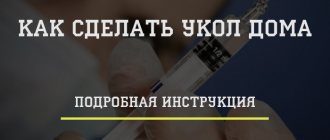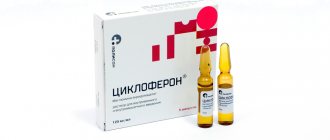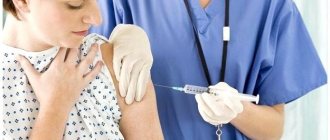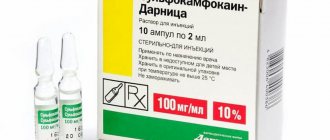Nosological classification (ICD-10)
- A38 Scarlet fever
- A46 Erysipelas
- A53.9 Syphilis, unspecified
- A66 Yaws
- B55.9 Leishmaniasis, unspecified
- I00 Rheumatic fever without mention of cardiac involvement
- I01 Rheumatic fever with cardiac involvement
- I05-I09 Chronic rheumatic heart disease
- J03.9 Acute tonsillitis, unspecified (angina agranulocytic)
- M79.0 Rheumatism, unspecified
- N74.2 Inflammatory diseases of the female pelvic organs caused by syphilis (A51.4+, A52.7+)
- T79.3 Post-traumatic wound infection, not elsewhere classified
Composition and release form
1 bottle (Bicillin-1) with powder for preparing an injection solution for intramuscular administration contains benzathine benzylpenicillin 600,000 units or 1,200,000 units.
1 bottle (Bicillin-3) with powder for the preparation of an injection solution for intramuscular administration contains benzathine benzylpenicillin, benzylpenicillin sodium and benzylpenicillin novocaine salt, 200,000 units or 400,000 units each; in 10 ml bottles or 10 ml bottles, 50 bottles in a box.
1 bottle with a capacity of 10 ml (Bicillin-5) with powder for preparing an injection solution for intramuscular administration contains benzathine benzylpenicillin 1,200,000 units and benzylpenicillin novocaine salt 300,000 units.
Characteristic
Bicillin-1 is a white, odorless or almost odorless powder that forms a stable suspension when water is added.
Bicillin-3 is a white or white powder with a slightly yellowish tint that forms a stable suspension when water is added.
Bicillin-5 is a white, odorless powder with a bitter taste, which forms a homogeneous suspension of milky turbidity when adding water, saline or 0.25–0.5% novocaine solution. With prolonged contact with water or other solutions, the physical and colloidal properties of the drug change (the suspension becomes uneven and difficult to pass through the syringe needle).
Pharmacodynamics
Active against gram-positive microorganisms, incl. Staphylococcus spp. (except for strains that produce penicillinase), Streptococcus spp. (including Streptococcus pneumoniae), Corynebacterium diphtheriae, anaerobic spore-forming bacilli Bacillus anthracis, some gram-negative microorganisms (including Neisseria gonorrhoeae, Neisseria meningitidis), Actinomyces israelii, as well as Treponema spp. Not effective against viruses (causative agents of influenza, polio, smallpox, etc.), mycobacterium tuberculosis, protozoa, rickettsia, fungi, as well as most gram-negative microorganisms.
Pharmacological properties of the drug Bicillin-3
The drug has a bactericidal effect by inhibiting the synthesis of mucopeptides in the cell membrane of microorganisms. Gram-positive microorganisms ( Staphylococcus spp., except those producing penicillinase, Streptococcus spp., except S. faecalis , Bacillus anthracis, Clostridium spp., Corynebacterium diphtheriae ), gram-negative cocci ( Neisseria gonorrhoae, Neisseria meningitidis ), Treponema pallidium are . Most gram-negative bacteria, mycobacteria, fungi, viruses, and protozoa are resistant to the drug. Bicillin is a long-acting form of benzylpenicillin. With intramuscular administration, a drug depot is formed in the muscle tissue. In the first hours after injection, a high level of benzylpenicillin is created in the blood serum. Well distributed in tissues and body fluids. High concentrations of the drug are achieved in the liver, kidneys, lungs, and mucous membranes; has the ability to penetrate fibrinous tissue. Bicillin is mainly excreted in the urine in a biologically active form (50–70%), in small quantities - in saliva, sweat, milk, and bile.
Pharmacokinetics
When administered intramuscularly, bicillin-1 is slowly absorbed, hydrolyzed to release benzylpenicillin, and enters the bloodstream over a long period of time. Cmax is reached within 12–24 hours, therapeutic concentration is achieved within 3–6 hours.
Bicillin-3 after intramuscular administration is slowly hydrolyzed to release benzylpenicillin. With a single injection, the therapeutic concentration in the blood is maintained for 6–7 days, Cmax is achieved 12–24 hours after injection. On the 14th day after administration at a dose of 2.4 million units, the serum concentration is 0.12 mcg/ml, on the 21st day after administration of 1.2 million units - 0.06 mcg/ml (1 unit = 0. 6 mcg). Binding to blood proteins is 40–60%. Penetration into liquids is high, into tissues low. Passes through the placental barrier and enters breast milk. It is biotransformed to a small extent and is excreted mainly by the kidneys.
With the intramuscular administration of Bicillin-5, high concentrations in the blood are created already in the first hours after the injection. After administration of 1.2–1.5 million units in most patients (adults and children), the therapeutic concentration in plasma (0.3 units/ml) persists for 28 days or more.
Bicillin-3 1,200 T.U. For Injection
Composition and release form
1 bottle (Bicillin?1) with powder for preparing an injection solution for intramuscular administration contains benzathine benzylpenicillin 600,000 units or 1,200,000 units.
1 bottle (Bicillin? 3) with powder for the preparation of an injection solution for intramuscular administration contains benzathine benzylpenicillin, benzylpenicillin sodium and benzylpenicillin novocaine salt, 200,000 units or 400,000 units each; in 10 ml bottles or 10 ml bottles, 50 bottles in a box.
1 bottle with a capacity of 10 ml (Bicillin? 5) with powder for preparing an injection solution for intramuscular administration contains benzathine benzylpenicillin 1,200,000 units and benzylpenicillin novocaine salt 300,000 units.
Description
Bicillin?1 is a white, odorless or almost odorless powder that forms a stable suspension when water is added. Bicillin?3 is a white or white powder with a slightly yellowish tint that forms a stable suspension when water is added. Bicillin?5 is a white, odorless powder with a bitter taste, which forms a homogeneous suspension of milky turbidity when adding water, saline or 0.25–0.5% novocaine solution. With prolonged contact with water or other solutions, the physical and colloidal properties of the drug change (the suspension becomes uneven and difficult to pass through the syringe needle).
pharmachologic effect
Pharmacological action - antibacterial, bactericidal. Inhibits the synthesis of peptidoglycan in the cell wall of microorganisms.
Pharmacodynamics
Active against gram-positive microorganisms, incl. Staphylococcus spp. (except for strains that produce penicillinase), Streptococcus spp. (including Streptococcus pneumoniae), Corynebacterium diphtheriae, anaerobic spore-forming bacilli Bacillus anthracis, some gram-negative microorganisms (including Neisseria gonorrhoeae, Neisseria meningitidis), Actinomyces israelii, as well as Treponema spp. Not effective against viruses (causative agents of influenza, polio, smallpox, etc.), mycobacterium tuberculosis, protozoa, rickettsia, fungi, as well as most gram-negative microorganisms.
Pharmacokinetics
When administered intramuscularly, bicillin-1 is slowly absorbed, hydrolyzed to release benzylpenicillin, and enters the bloodstream over a long period of time. Cmax is reached within 12–24 hours, therapeutic concentration is achieved within 3–6 hours. Bicillin-3 after intramuscular administration is slowly hydrolyzed to release benzylpenicillin. With a single injection, the therapeutic concentration in the blood is maintained for 6–7 days, Cmax is achieved 12–24 hours after injection. On the 14th day after administration at a dose of 2.4 million units, the serum concentration is 0.12 mcg/ml, on the 21st day after administration of 1.2 million units - 0.06 mcg/ml (1 unit = 0. 6 mcg). Binding to blood proteins is 40–60%. Penetration into liquids is high, into tissues low. Passes through the placental barrier and enters breast milk. It is biotransformed to a small extent and is excreted mainly by the kidneys. With the intramuscular administration of Bicillin?5, high concentrations in the blood are created already in the first hours after the injection. After administration of 1.2–1.5 million units in most patients (adults and children), the therapeutic concentration in plasma (0.3 units/ml) persists for 28 days or more.
Indications of the drug
Infectious diseases caused by microorganisms sensitive to the drug (especially when long-term maintenance of therapeutic concentration is necessary), incl. acute tonsillitis, scarlet fever, wound infections, erysipelas; rheumatism (prevention and treatment) caused by treponemes (syphilis, yaws), leishmaniasis.
Contraindications
Hypersensitivity (including to other penicillins and drug components). With caution - bronchial asthma, hay fever, urticaria and other allergic diseases; hypersensitivity to various drugs, incl. to antibiotics and sulfonamides (in history).
Side effects
From the cardiovascular system and blood (hematopoiesis, hemostasis): anemia, thrombocytopenia, leukopenia, hypocoagulation. Allergic reactions: rash on the skin and mucous membranes, urticaria, eosinophilia, joint pain, erythema multiforme, exfoliative dermatitis, Quincke's edema, anaphylactic shock. Other: headache, fever, arthralgia, stomatitis, glossitis, pain at the injection site; with long-term therapy - superinfection caused by drug-resistant microorganisms and fungi.
Interaction
Bactericidal antibiotics (including cephalosporins, cycloserine, vancomycin, rifampicin, aminoglycosides) have a synergistic effect, bacteriostatic (including macrolides, chloramphenicol, lincosamides, tetracyclines) have an antagonistic effect. Reduces the effectiveness of oral contraceptives and ethinyl estradiol (risk of breakthrough bleeding). Diuretics, allopurinol, phenylbutazone, NSAIDs reduce tubular secretion and increase concentration. Allopurinol increases the risk of allergic reactions (skin rash).
Directions for use and doses
IM, deep, into the upper outer quadrant of the gluteal muscle (IV administration is prohibited). Bicillin?1 for the prevention and treatment of infectious diseases in adults - 300,000 units and 600,000 units once a week or 1.2 million units 2 times a month. When treating rheumatism in adults, the dose is increased to 2.4 million units 2 times a month. To prevent relapses of rheumatism - 600,000 units once a week for 6 weeks in combination with acetylsalicylic acid or other NSAIDs. Treatment of syphilis is carried out according to special instructions. The average dose is 2.4 million units 2-3 times at intervals of 8 days. Bicillin?3 - in a dose of 300,000 units (if necessary, 2 injections are given in different buttocks). Repeated injections are carried out 4 days after the previous injection. A dose of 600,000 units is administered once every 6 days. For the treatment of primary and secondary syphilis, a single dose is 1.8 million units. The course of treatment is 7 injections. The first injection is carried out at a dose of 300,000 units, the second injection - after 1 day at the full dose, subsequent injections are carried out 2 times a week. In the treatment of secondary recurrent and latent early syphilis, a dose of 300,000 units is used for the first injection, and 1.8 million units for subsequent injections. Injections are carried out 2 times a week. The course of treatment is 14 injections. Bicillin?5 adults - 1.5 million units once every 4 weeks, children under 8 years old - 600,000 units once every 3 weeks, children over 8 years old - 1.2–1.5 million units once every 4 weeks. The suspension is prepared under aseptic conditions immediately before use (5-6 ml of sterile distilled water, 0.9% sodium chloride solution or 0.25-0.5% novocaine solution is added to a bottle containing 1.5 million units). The mixture in the bottle is shaken for 30 s in the direction of the longitudinal axis until a homogeneous suspension (or suspension) is formed and immediately administered.
Precautionary measures
If blood appears in the syringe during an intramuscular injection (indicating that the needle has entered a blood vessel), the syringe should be removed and injected elsewhere. At the end of the injection, the injection site is pressed with a cotton swab, which prevents the drug from entering the muscle tissue into the subcutaneous tissue (rubbing the buttock after the injection is not recommended). If an allergic reaction develops, treatment is stopped immediately. When the first signs of anaphylactic shock appear, it is necessary to take urgent measures to remove the patient from this state: administration of norepinephrine, glucocorticoids, etc., and, if necessary, mechanical ventilation. When treating sexually transmitted diseases, if syphilis is suspected, microscopic and serological studies are necessary before starting therapy and then for 4 months. Due to the possibility of developing fungal infections, it is advisable to prescribe B vitamins and vitamin C, and, if necessary, nystatin and levorin. It must be taken into account that using the drug in insufficient doses or stopping treatment too early often leads to the emergence of resistant strains of pathogens.
special instructions
IV administration of the drug should not be allowed (possible development of Wanier syndrome - the development of a feeling of depression, anxiety and visual impairment).
Storage conditions
At a temperature of 8–15 °C. Keep out of the reach of children.
Best before date
3 years. Do not use after the expiration date stated on the package.
Side effects
From the cardiovascular system and blood (hematopoiesis, hemostasis): anemia, thrombocytopenia, leukopenia, hypocoagulation.
Allergic reactions: rash on the skin and mucous membranes, urticaria, eosinophilia, joint pain, erythema multiforme, exfoliative dermatitis, Quincke's edema, anaphylactic shock.
Other: headache, fever, arthralgia, stomatitis, glossitis, pain at the injection site; with long-term therapy - superinfection caused by drug-resistant microorganisms and fungi.
Side effects of the drug Bicillin-3
When using Bicillin-3 CMP, local and generalized allergic reactions may develop - stomatitis, glossitis, urticaria, fever, arthralgia, angioedema, polymorphic erythema, anaphylactic shock. Patients who have experienced unusual reactions to the drug should be under constant medical supervision until these phenomena disappear completely. In severe cases, 0.5–0.6 ml of 0.1% atropine solution is administered, injections of 1 ml of 0.1% epinephrine solution or 1 ml of 5% ephedrine solution, injection of 1–2 ml of 2% solution -ra chloropyramine. After injection of the drug (like other long-acting penicillin preparations), pain at the injection site is possible.
Interaction
Bactericidal antibiotics (including cephalosporins, cycloserine, vancomycin, rifampicin, aminoglycosides) have a synergistic effect, bacteriostatic (including macrolides, chloramphenicol, lincosamides, tetracyclines) have an antagonistic effect. Reduces the effectiveness of oral contraceptives and ethinyl estradiol (risk of breakthrough bleeding). Diuretics, allopurinol, phenylbutazone, NSAIDs reduce tubular secretion and increase concentration. Allopurinol increases the risk of allergic reactions (skin rash).
Directions for use and doses
IM, deep, into the upper outer quadrant of the gluteal muscle (IV administration is prohibited).
Bicillin-1 for the prevention and treatment of infectious diseases in adults - 300,000 units and 600,000 units once a week or 1.2 million units 2 times a month. When treating rheumatism in adults, the dose is increased to 2.4 million units 2 times a month. To prevent relapses of rheumatism - 600,000 units once a week for 6 weeks in combination with acetylsalicylic acid or other NSAIDs.
Treatment of syphilis is carried out according to special instructions. The average dose is 2.4 million units 2-3 times at intervals of 8 days.
Bicillin-3 - in a dose of 300,000 units (if necessary, 2 injections are given in different buttocks). Repeated injections are carried out 4 days after the previous injection. A dose of 600,000 units is administered once every 6 days.
For the treatment of primary and secondary syphilis, a single dose is 1.8 million units. The course of treatment is 7 injections. The first injection is carried out at a dose of 300,000 units, the second injection - after 1 day at the full dose, subsequent injections are carried out 2 times a week.
In the treatment of secondary recurrent and latent early syphilis, a dose of 300,000 units is used for the first injection, and 1.8 million units for subsequent injections. Injections are carried out 2 times a week. The course of treatment is 14 injections.
Bicillin-5 for adults - 1.5 million units once every 4 weeks, for children under 8 years old - 600,000 units once every 3 weeks, for children over 8 years old - 1.2–1.5 million units once every 4 weeks.
The suspension is prepared under aseptic conditions immediately before use (5-6 ml of sterile distilled water, 0.9% sodium chloride solution or 0.25-0.5% novocaine solution is added to a bottle containing 1.5 million units). The mixture in the bottle is shaken for 30 s in the direction of the longitudinal axis until a homogeneous suspension (or suspension) is formed and immediately administered.
Use of the drug Bicillin-3
The drug is prescribed only to adults. Before administration, it is necessary to conduct a preliminary intradermal test to determine the tolerability of the drug. Bicillin-3 is administered only intramuscularly. IV administration of the drug is prohibited. The suspension is prepared sterile immediately before use. Add 5–6 ml of isotonic sodium chloride solution or sterile water for injection, or 0.25–0.5% procaine solution to the bottle, mix until a uniform suspension is obtained and inject deeply intramuscularly into the upper outer quadrant of the gluteal muscle at a dose of 600,000 units once every 6 days. Before administering the Bicillin-3 suspension, you must make sure that the needle does not enter a blood vessel. If blood appears, the needle must be removed and injected elsewhere.
Precautionary measures
If blood appears in the syringe during an intramuscular injection (indicating that the needle has entered a blood vessel), the syringe should be removed and injected elsewhere. At the end of the injection, the injection site is pressed with a cotton swab, which prevents the drug from entering the muscle tissue into the subcutaneous tissue (rubbing the buttock after the injection is not recommended).
If an allergic reaction develops, treatment is stopped immediately. When the first signs of anaphylactic shock appear, it is necessary to take urgent measures to remove the patient from this state: administration of norepinephrine, glucocorticoids, etc., and, if necessary, mechanical ventilation.
When treating sexually transmitted diseases, if syphilis is suspected, microscopic and serological studies are necessary before starting therapy and then for 4 months.
Due to the possibility of developing fungal infections, it is advisable to prescribe B vitamins and vitamin C, and, if necessary, nystatin and levorin. It must be taken into account that using the drug in insufficient doses or stopping treatment too early often leads to the emergence of resistant strains of pathogens.
Bicillin®-1 (Bicillin-1)
The drug is injected only deep intramuscularly into the upper outer quadrant of the buttock. If blood appears in the syringe, indicating that the needle has entered the vessel, you should remove the syringe and inject into another place. If two injections are necessary, the drug should be injected into different buttocks.
The drug cannot be administered intravenously!
For adults
for
preventive treatment of syphilis,
a single dose of 2.4 million units is prescribed;
for primary syphilis
- 1 injection (2.4 million units) intramuscularly with an interval of 7 days (course - 2 injections);
for secondary and early latent syphilis
- 1 injection (2.4 million units) intramuscularly with an interval of 7 days (course - 3 injections).
For the preventive treatment
of a child born to a mother with untreated syphilis,
1 injection (50,000 units/kg body weight) intramuscularly with an interval of 7 days (course of 3 injections), the dose is divided in half and administered into different buttocks.
For preventive treatment
of a child due to insufficient treatment of the mother or seroresistance of syphilis
- 1 injection (50,000 units/kg body weight) intramuscularly with an interval of 7 days (course - 2 injections).
When treating yaws and pinta (endemic treponematoses)
for children
- 1.2 million units once;
adults
- 2.4 million units once.
For acute tonsillitis, scarlet fever, erysipelas, wound infections in the acute phase
for children under 12 years of age -
0.6 million units every 3 days or 1.2 million units every 2-4 weeks, depending on the severity of the infection;
adults
- 1.2-2.4 million units once a week.
To prevent recurrent attacks after acute rheumatic fever,
children weighing <25 kg
- 0.6 million units once every 3 weeks;
children weighing >25 kg
- 1.2 million units once every 3 weeks;
for adolescents and adults
- 2.4 million units once every 3 weeks. The duration of prophylaxis is determined individually.
To prevent recurrence of erysipelas
for children
- 0.6 units once every 2 weeks or 1.2 million units every 3-4 weeks;
adults
with
seasonal relapses
- 2.4 million units once every 4 weeks for 3-4 months annually;
with frequent relapses
- 2.4 million units once every 3-4 weeks for 2-3 years.
For the prevention of postoperative infections
for children
- 0.6 million units or 1.2 million units;
adults
- 2.4 million units every 7-14 days until complete recovery.
For renal failure
doses are reduced in accordance with CC: with
CC from 10 to 50 ml/min,
75% of the daily dose of the drug is administered, with
CC <10 ml/min,
25-50% of the daily dose of the drug is administered.
Rules for preparing the solution
A suspension of the drug is prepared under aseptic conditions immediately before use: 3-5 ml of water for injection or 0.9% sodium chloride solution is added to the bottle. The mixture is stirred until a uniform suspension is obtained, quickly rotating the bottle between the palms for at least 1 minute or gently shaking the bottle in the direction of its longitudinal axis for 30 seconds.




